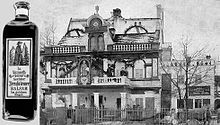Wzgórze Marii (Wojciechowice)
Wzgórze Marii ( German Spittelberg ) is a Marian pilgrimage site near Wojciechowice ( Königshain ) in the powiat Kłodzki in the Lower Silesian Voivodeship in Poland .
The Spittelberg with the small church "Maria Trost", a Marian column , a way of the cross and a hermit dwelling is located on the right hand side when coming from Glatz at the entrance of Königshain on a hill about 30 meters above the Königshain brook.
history
About the origin of the chapel on the Spittelberg, it was said that a Glatzer sailor, after a happy return home from pirate captivity and slavery, redeemed a vow by making an image of the Mother of God. Since he had to worship a black idol in captivity, it was in a certain way fitting that he chose a strangely shaped piece of black wood with the suggestion of a figure of Mary made from the wood rafted on the Neisse for the production of the statue. He attached the figure to a tree on the Spittelberg. In 1715 a mill owner had a small chapel built for it. This was destroyed during the invasion of Napoleon's army in 1807, but then rebuilt, later supplemented with a Way of the Cross and a hermitage.
The right of ownership to Spittelberg was temporarily held by the Scheibe (Polish: Skiba ) hospital , before the Franciscans took over the care of the Spittelberg in 1915 . After almost all of Silesia fell to Poland in 1945 as a result of the Second World War , the Franciscans were expelled from Glatz in November 1946.
Jerusalem balm
The Spittelberg is connected with another specialty. The first hermit on the Spittelberg was Johannes Treutler from 1846. In the 1860s he came up with the idea of producing a healing balm, which he called "Jerusalem balm", based on a recipe that a pilgrim had allegedly brought with him and selling it to the pilgrims. In a short time this balm became a popular medicine in the entire County of Glatz and a great financial success. Treutler later also produced ointments, pills and teas. When, for whatever reason, he had to take off his spiritual clothing, he became a wealthy man. He built several houses, one of them, the "Treutlerburg", right at the foot of the Spittelberg.
Treutler bequeathed his prescriptions to the Scheibe medical convent, which she sold to the Mohren pharmacy in Glatz. Its owner, Johannes Schittny, registered the trademark. After the expulsion, his son Hans Richard Schittny still produced under the name "Einsiedler Balsam" until the end of the 1980s. He described that similar recipes were already known in the 17th century.
Web links
Individual evidence
- ↑ a b Aloys Bernatzky : Lexicon of the County of Glatz . Marx Verlag Leimen / Heidelberg 2nd edition 1994
- ↑ Hans Richard Schittny: About the origin of the Jerusalem balm . Pharmaceutical Gazette No. 33, Volume 136, August 15, 1991, pp. 24–28 (PDF file 1.4 MB)
Coordinates: 50 ° 26 ′ 57.5 " N , 16 ° 40 ′ 55.9" E


